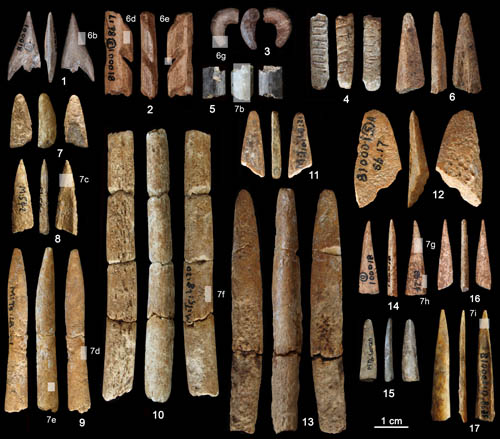| Location: Home > Research > Research Progress |
| Paleolithic Bone Tools Found from South China |
|
The production of formal bone tools, defined as artefacts that were cut, carved, polished or otherwise modified to produce fully shaped points, awls, harpoons and wedges, appears relatively late in human history, and is only recorded at a handful of African sites prior to 45000 years ago. Early instances of bone technology in other areas of the Old World such as China, are however still rare, and those that are known are often insufficiently documented. In a paper published in Journal of Archaeological Science in Janurary, a research team led by Dr. Gao Xing,Institute of Vertebrate Paleontology and Paleoanthropology (IVPP), Chinese Academy of Sciences, and Dr. Francesco d’Errico, Université de Bordeaux present their results of a techno-functional analysis of 17 bone tools recovered the Palaeolithic site of Ma'anshan Cave, Guizhou Province, southern China. These implements are the oldest formal bone tools from China, and the barbed points are amongst the oldest known outside Africa. Ma'anshan Cave (106°49’37’’E, 28°07’18’’N ) is located 2 km southeast of Tongzi County, northwest Guizhou Province. The cave lies at an altitude of 960 m above sea level, and 40 m above the nearby Tianmen River. Excavations were systematically carried out in 1986 and 1990 by an IVPP team, and eight archaeological layers were clearly recognized. The 17 formal bone tools were recovered from strata 6, 5 and 3 of the Palaeolithic site of Ma’anshan Cave. Stratum 6, dated to about 35000 years ago, has yielded three sharp awls. From Stratum 5, dated to about 34000 years ago, come six probable spear points, awls and a cutting tool. Separated from these layers by a sterile horizon, Stratum 3, dated about 23000 to 18000 years ago, has yielded barbed points of two types. Bone tools were shaped by scraping, grinding, and in strata 5 and 3, finished by polishing. “Ma’anshan Cave records the oldest formal bone tools from China, and amongst the oldest known evidence of indisputable barbed point manufacture outside Africa”, said lead author Dr. ZHANG Shuangquan of the IVPP, “Change in the hunting toolkit between strata 5 and 3 may indicate a shift in prey preference from medium to small size mammals and fish, which needs to be verified by supplementary analyses. This finding provides new materials for studies about the origin of bone tool technology in Africa and Eurasia”. “As at other sites from China, lithic technology at Ma'anshan remains relatively unchanged through time, our study demonstrates that bone tool technology shows rates of cultural turnover comparable to those observed in the Upper Palaeolithic of Europe”, said Dr. GAO Xing of the IVPP. This work was supported by grants from the Key Research Program of the Chinese Academy of Sciences, the Strategic Priority Research Program of the Chinese Academy of Sciences, the National Natural Science Foundation of China, and the Sino-French Cai Yuanpei Programme.
Fig. 1 Bone artefacts recovered from the Ma’anshan site (Image by ZHANG Shuangquan).
Fig. 2 Traces of manufacture on Ma’anshan bone artefacts (Image by ZHANG Shuangquan). Contact: Email:zhangshuangquan@ivpp.ac.cn Institute of Vertebrate Paleontology and Paleoanthropology, Chinese Academy of Sciences |

